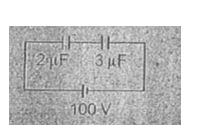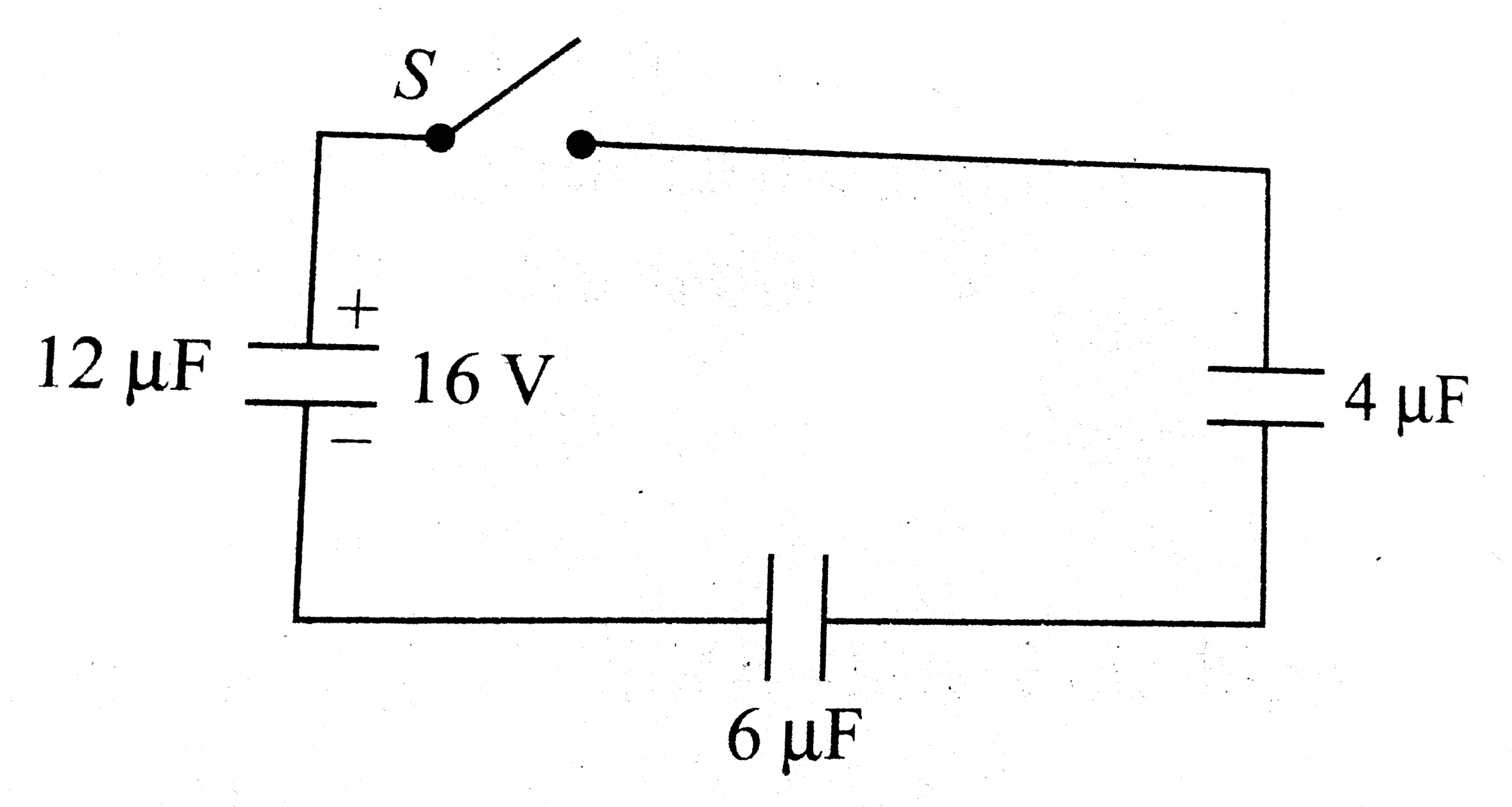A 100μF capacitor is charged to a potential difference of 24V. It is connected to an uncharged capacitor of capacitance 20μF What will be the new potential difference across the 100μF capacitor?
To solve the problem, we need to follow these steps:
Step 1: Calculate the initial charge on the 100 µF capacitor.
The charge Q on a capacitor is given by the formula:
Q=C×V
Where:
- C is the capacitance,
- V is the potential difference.
For the 100 µF capacitor charged to 24 V:
Q1=100μF×24V=2400μC
Step 2: Understand the system after connecting the uncharged capacitor.
When the 100 µF capacitor is connected to the uncharged 20 µF capacitor, charge will redistribute between the two capacitors until they reach the same potential difference.
Step 3: Set up the equation for charge conservation.
Let Q2 be the charge on the 20 µF capacitor after they are connected. The total charge before connecting the capacitors is equal to the total charge after they are connected:
Q1=Q′1+Q2
Where Q′1 is the new charge on the 100 µF capacitor.
Step 4: Write the relationship between the charges and voltages.
Since both capacitors will have the same potential difference V′ after connection:
V′=Q′1C1=Q2C2
Where:
- C1=100μF
- C2=20μF
Step 5: Substitute the expressions for charges.
From the charge conservation equation:
Q1=Q′1+Q2⟹2400μC=Q′1+Q2
And from the potential equality:
Q′1=C1×V′andQ2=C2×V′
Substituting these into the charge conservation equation gives:
2400=C1×V′+C2×V′
2400=(C1+C2)×V′
2400=(100+20)×V′
2400=120×V′
Step 6: Solve for the new potential difference V′.
V′=2400120=20V
Conclusion:
The new potential difference across the 100 µF capacitor after connecting it to the uncharged 20 µF capacitor is 20 V.
---
The charge Q on a capacitor is given by the formula:
Q=C×V
Where:
- C is the capacitance,
- V is the potential difference.
Q1=100μF×24V=2400μC
When the 100 µF capacitor is connected to the uncharged 20 µF capacitor, charge will redistribute between the two capacitors until they reach the same potential difference.
Let Q2 be the charge on the 20 µF capacitor after they are connected. The total charge before connecting the capacitors is equal to the total charge after they are connected:
Q1=Q′1+Q2
Where Q′1 is the new charge on the 100 µF capacitor.
Since both capacitors will have the same potential difference V′ after connection:
V′=Q′1C1=Q2C2
Where:
- C1=100μF
- C2=20μF
From the charge conservation equation:
Q1=Q′1+Q2⟹2400μC=Q′1+Q2
And from the potential equality:
Q′1=C1×V′andQ2=C2×V′
Substituting these into the charge conservation equation gives:
2400=C1×V′+C2×V′
2400=(C1+C2)×V′
2400=(100+20)×V′
2400=120×V′
V′=2400120=20V
The new potential difference across the 100 µF capacitor after connecting it to the uncharged 20 µF capacitor is 20 V.
Topper's Solved these Questions
- CAPACITORSBOOK - HC VERMA ENGLISHCHAPTER - CAPACITORSEXERCISE - short answer
7 Videos
- CAPACITORSBOOK - HC VERMA ENGLISHCHAPTER - CAPACITORSEXERCISE - OBJECTIVE 2
6 Videos
- BOHR'S MODEL AND PHYSICS OF THE ATOMBOOK - HC VERMA ENGLISHCHAPTER - BOHR'S MODEL AND PHYSICS OF THE ATOMEXERCISE - Short Answer
10 Videos
- DISPERSION AND SPECTRABOOK - HC VERMA ENGLISHCHAPTER - DISPERSION AND SPECTRAEXERCISE - Question for short Answer
6 Videos
Similar Questions
A 10μF capacitor is charged to a potential difference of 50V and is connected to another uncharged capacitor in parallel. Now the common potential difference becomes 20 volt. The capacitance of second capacitor is
View SolutionA 10μF capacitor is charged to a potential difference of 50V and is connected to another uncharged capacitor in parallel. Now the common potential difference becomes 20 volt. The capacitance of second capacitor is
View Solution
Knowledge Check
A capacitor or capacitance C1 is charge to a potential V and then connected in parallel to an uncharged capacitor of capacitance C2. The fianl potential difference across each capacitor will be
AC1VC1+C2BC2VC1+C2C1+C2C1D1−C2C1
A capacitor of capacitance 2.0μF is charged to a potential difference of 12 V. It is then connected to an uncharged capacitor of capacitance 4.0μF. Find (a) the charge flow through connecting wire upto study strate on each of the two capacitors after the connection in μC (b) The total electrostatic energy stored in both capacitors in μJ (c) the heat produced during the charge transfer from one capacitor to the other in μJ.
View SolutionA capacitor of capacity 2μF is charged to a potential difference of 12V. It is then connected across an inductor of inductance 6μH. At an instant when potential difference across the capacitor is 6V, what is the current(in A)?
View SolutionFind charge on each capacitor and potential difference across each capacitor .

View SolutionFind the energy stored in a capacitor of capacitance 100μF when it is charged to a potential difference of 20 V.
View SolutionA capacitor of capacitance C is charged to a potential difference V from a cell and then disconncted from it. A charge +Q is now given to its positive plate. The potential difference across the capacitor is now
View SolutionA capacitor of capacitance C is charged to a potential difference V from a cell and then disconncted from it. A charge +Q is now given to its positive plate. The potential difference across the capacitor is now
View SolutionIn the arrangement shown in , the switch S is find
 the final potential difference across the 4μF capacitor
the final potential difference across the 4μF capacitor
View Solution
